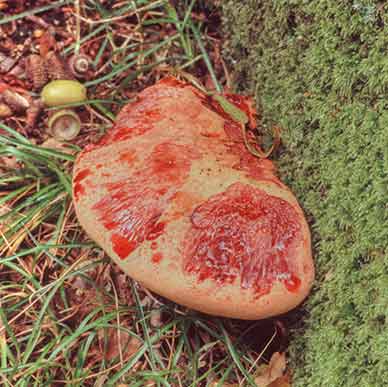Beefsteak Fungus (Fistulina hepatica)

Beefsteak Fungus: the name alone is enough to encourage enthusiastic fungus foragers to lick their lips. And whilst one of its other common names, the ox-tongue, doesn't have quite the same appeal, it is particularly appropriate for this not uncommon fungus has been likened in appearance to a huge tongue. The scientific name, however, is just as descriptive for it comes from the Greek for 'liver-like'.
Found as a parasite on sweet chestnut and oak, it's a bracket fungus that appears in late summer and autumn. The cap can extend to as much as 30 centimetres across and is usually 2 - 6 centimetres thick.
Beafsteak Fungus flesh is thick, fibrous and succulent, mottled dark pink and with blood-like sap, just like raw meat. It is very edible - it can be eaten raw and apparently has a lemony tart flavour and pleasing texture - although when old, it dries out, turns blackish brown and becomes rather tough; but in all stages can be used to make excellent gravy.
Young specimens, when sliced and grilled, pass for beefsteak, which led to another old country name: Poor Man’s Meat.
Warning: refer to a good, comprehensive fungus field guide to confirm identification, and only eat those species known without any doubt whatsoever to be edible - people have died after eating certain poisonous specimens.
References:
Mushrooms and other Fungi of Great Britain and Europe - Roger Phillips
The Mushrooms and Toadstools of Britain and North-western Europe - Marcel Bon
Fungi of Britain and Europe - Stefan Buczacki and John Wilkinson
The MacDonald Encyclopedia of Mushrooms and Toadstools - Giovanni Pacioni
Fungi of the New Forest: A Mycota - Edited by Gordon Dickson and Ann Leonard
A Passion for Mushrooms - Antonio Carluccio
More links
Other related links
Search this site

Sadly, 58 animals were killed - 35 ponies, 13 cows, 8 donkeys and 2 sheep, whilst a further 32 were injured - 3 pigs, 9 donkeys, 11 cows and 9 ponies.
(Forty-three accidents occurred in daylight, 15 at twilight and 101 in the dark. Twenty-seven accidents were not reported by the driver involved).
Here's just one horrific example - Three donkeys killed in collision with van at notorious New Forest blackspot (Advertiser and Times)

